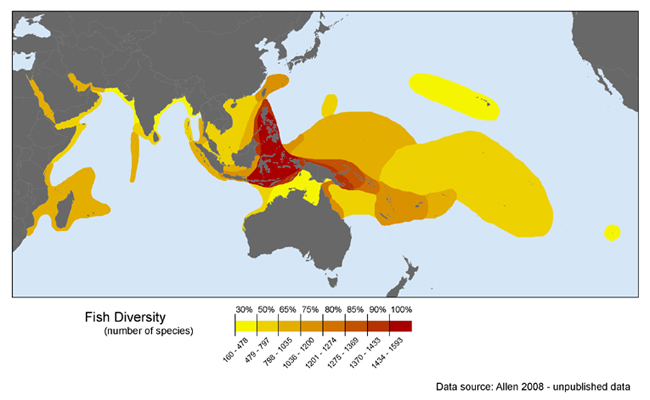The Coral Triangle
The Coral Triangle is an area encompassing almost 4 million square miles of ocean and coastal waters in Southeast Asia and the Pacific surrounding Indonesia, Malaysia, Papua New Guinea, the Philippines, Timor Leste, and the Solomon Islands. The Coral Triangle is also home to some 363 million people and encompasses economic zones in which each country has exclusive rights to marine resources. Recognized as the global center of marine biological diversity, the region serves as the spawning and juvenile growth areas for five species of tuna, comprising the largest tuna fisheries in the world. The biological resources of the Coral Triangle directly sustain the lives of more than 120 million people living within this area, and benefit millions more worldwide.

Biodiversity
The Coral Triangle is regarded as the global epicenter of marine biodiversity (Allen 2007; Hoeksema 2007, Veron 1995, 2000, Veron et al. 2009), and a global priority for conservation (Allen 2000; Briggs 2005a; Hughes et al. 2002; Roberts et al. 2002; Wallace et al. 2001).

Coral Diversity
- The Coral Triangle comprises the highest coral diversity in the world (Figure 1): 76% (605) of the world’s coral species (798). By comparison, approximately 8% of coral species (61) occur in the Caribbean.
- Highest coral diversity resides in the Bird’s Head Peninsula of Indonesian Papua which hosts 574 species (95% of CT total, and 72% of the world's total.
- Within the Bird’s Head Peninsula, Raja Ampat is the World’s coral diversity bull’s eye with 553 species.

Fish Diversity
- The Coral Triangle comprises the highest diversity of coral reef fishes in the world: 37% (2228) of the world’s coral reef fish species (6000), and 56% of the coral reef fishes in the Indo-Pacific region (4050).
- By comparison, 7% (420) of the world’s coral reef fish species occur in the Hawaiian Islands.
- The highest concentration of reef fish species extends from south-eastern Indonesia to central Philippines.
- Coral Triangle countries have some of the highest numbers of endemic reef fish species in the world (particularly Indonesia, Philippines and PNG).
- Within the Coral Triangle, four areas have particularly high levels of endemism: Lesser Sunda Islands, Papua New Guinea – Solomon Islands, Bird’s Head Peninsula, and Central Philippines.
 For more facts on biodiversity: Soundbite Part II
For more facts on biodiversity: Soundbite Part II
Geographic Statistics
| Indonesia | Malaysia | Papua New Guinea | Philippines | Solomon Islands | Timor-Leste | |
|---|---|---|---|---|---|---|
| Marine Area (km2) | 2,915,000 | 198,200 | 2,403,355 | 293,800 | N/A | 77,474 |
| MPA Area (km2) | 187,221 | 3,856 | 4,550 | 10,724 | 402 | 586 |
| Number of MPA | 189 | 51 | 74 | 632 | 291 | 31 |
| Coastline (km) | 54,716 | 4,675 | 5,152 | 36,289 | 5,313 | 706 |
| Coral Reef Area (km2) | 19,805 | 1,687 | 7,126 | 11,852 | 2,802 | 35 |
| Mangrove Area (km2) | 29,631 | 7,041 | 4,159 | 2,562 | 614 | 0 |
| Publication | 9 | 11 | 10 | 10 | 10 | 10 |
| Photo | 11 | 11 | 10 | 10 | 11 | 10 |
